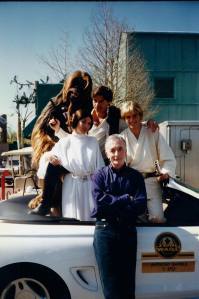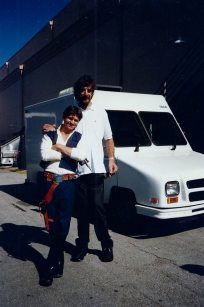Jack Castle's Blog
September 26, 2015
The Morning Stampede K102.5 Country!
I had a radio interview with Derik and Jeff from K102.5 Country.
Watch to see DJ Derik of The Morning Stampede learning how to take a punch!
Tagged: Country, Derik and Jeff, DJ, K102.5, learning how to take a punch, radio interview, Stunt video, The Morning Stampede


Published on September 26, 2015 09:18
September 8, 2015
Exploring W. W. II Bunkers on a Remote Alaskan Island
Exploring W.W. II Bunkers on a Remote Alaskan Island!
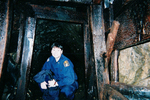
Recently, an eighth grade girl doing a book report on Europa Journal asked me, “Where did you get the idea for the pyramid on Europa’s slushy ocean floor?”
The question took me by surprise and I was suddenly assaulted by an old memory.
While working as a Captain on Shemya Island I had the opportunity to explore hidden underground bunkers left over by the Japanese occupation during World War Two.
This 2 mile x 4 mile island, more commonly referred to as “The Rock”, is the second to last island in the Alaskan Aleutian chain, 200 miles from Russia and 1500 miles from Anchorage. There are no native inhabitants on the island and a secret clearance with the military is required.
Shemya Island is also known for being surrounded by the worst flying conditions in the world. When I first arrived we landed our C-130 in hurricane force winds. The weather can literally change in a flash, sunny and balmy one minute and the next your dodging softball-sized hailstones that can smash out windshields!
My favorite experience on “The Rock” however was exploring the underground bunkers left behind by the Japanese during their occupation of the island in World War Two. My Sergeant had guided me into several of the concrete tombs and submerged Quonset huts but I wanted to find something lost to time. So in my spare time I did some research. I soon stumbled across some old W.W. II maps drawn shortly after the U.S. had first reclaimed the island. I then compared the old maps with the more modern ones. I asked my Sergeant if he had ever been to one particular tunnel dug right into the side of the mountain on the south beach. He informed me that he had not and most likely if there were any tunnels or caves at that location they most likely had collapsed long ago.
The next day we drove our patrol vehicle down the south beach and scouted the coordinates. From the beach it appeared as though the Sergeant was right, for all I could see was thick grasses along the cliffs. Much to the displeasure of my slightly overweight Sergeant, I decided we should climb up and have a look. The climb was slow-going and treacherous because most of our handholds were comprised of volcanic rock that crumbled in our hands.
About halfway up the cliffs I pushed aside some thick vegetation and spotted a hole about the size and shape of a large doggy door. After about an hour of digging away the mud and rock with our hands we found an entrance.
I instructed my Sergeant to switch to a secure channel and inform dispatch of our exact position, and if they did not hear from us in one hour to come running with shovels. By the time he was able to get a signal and make the call, I had cleared away enough mud, vegetation and rock for us to enter.
Using only our flashlights, we cautiously moved down a narrow, man made tunnel of solid rock that was only about five feet high and 3 feet wide. Water constantly dripped down us from the ceiling and on the floor we discovered remnants of old rail car tracks. About thirty feet in the water rose to our kneecaps. My Sergeant wasn’t too keen on going any further so I sojourned onward alone. About sixty more feet inside I finally reached the end of the tunnel where an elevator shaft had purposely been caved in with dynamite.
It wasn’t until weeks later that I learned that the Japanese used to land supply ships on the south beach. Oil drums were then lifted to the mouth of the cave via cable-and-pulley system, loaded onto the carts, and railed through the tunnel. The oil drums were then loaded onto the elevator and lifted up to the inside of a hanger located on the top of the plateau.
A week after I had left the island an officer had fallen through a floor in one of the underground passages and was seriously injured on some rebar. Since then, all exploration of these bunkers lost in time have been strictly forbidden.
And so the story of Europa Journal’s underwater pyramid began.
Tagged: Alaska, C-130, Europa Journal, maps, Ocean floor, Plateau, pyramid, Quonset, Rebar, Remote Island, Sergeant, Shemya Island, slushy, The Rock, World War II


Recently, an eighth grade girl doing a book report on Europa Journal asked me, “Where did you get the idea for the pyramid on Europa’s slushy ocean floor?”
The question took me by surprise and I was suddenly assaulted by an old memory.
While working as a Captain on Shemya Island I had the opportunity to explore hidden underground bunkers left over by the Japanese occupation during World War Two.
This 2 mile x 4 mile island, more commonly referred to as “The Rock”, is the second to last island in the Alaskan Aleutian chain, 200 miles from Russia and 1500 miles from Anchorage. There are no native inhabitants on the island and a secret clearance with the military is required.
Shemya Island is also known for being surrounded by the worst flying conditions in the world. When I first arrived we landed our C-130 in hurricane force winds. The weather can literally change in a flash, sunny and balmy one minute and the next your dodging softball-sized hailstones that can smash out windshields!
My favorite experience on “The Rock” however was exploring the underground bunkers left behind by the Japanese during their occupation of the island in World War Two. My Sergeant had guided me into several of the concrete tombs and submerged Quonset huts but I wanted to find something lost to time. So in my spare time I did some research. I soon stumbled across some old W.W. II maps drawn shortly after the U.S. had first reclaimed the island. I then compared the old maps with the more modern ones. I asked my Sergeant if he had ever been to one particular tunnel dug right into the side of the mountain on the south beach. He informed me that he had not and most likely if there were any tunnels or caves at that location they most likely had collapsed long ago.
The next day we drove our patrol vehicle down the south beach and scouted the coordinates. From the beach it appeared as though the Sergeant was right, for all I could see was thick grasses along the cliffs. Much to the displeasure of my slightly overweight Sergeant, I decided we should climb up and have a look. The climb was slow-going and treacherous because most of our handholds were comprised of volcanic rock that crumbled in our hands.
About halfway up the cliffs I pushed aside some thick vegetation and spotted a hole about the size and shape of a large doggy door. After about an hour of digging away the mud and rock with our hands we found an entrance.
I instructed my Sergeant to switch to a secure channel and inform dispatch of our exact position, and if they did not hear from us in one hour to come running with shovels. By the time he was able to get a signal and make the call, I had cleared away enough mud, vegetation and rock for us to enter.
Using only our flashlights, we cautiously moved down a narrow, man made tunnel of solid rock that was only about five feet high and 3 feet wide. Water constantly dripped down us from the ceiling and on the floor we discovered remnants of old rail car tracks. About thirty feet in the water rose to our kneecaps. My Sergeant wasn’t too keen on going any further so I sojourned onward alone. About sixty more feet inside I finally reached the end of the tunnel where an elevator shaft had purposely been caved in with dynamite.
It wasn’t until weeks later that I learned that the Japanese used to land supply ships on the south beach. Oil drums were then lifted to the mouth of the cave via cable-and-pulley system, loaded onto the carts, and railed through the tunnel. The oil drums were then loaded onto the elevator and lifted up to the inside of a hanger located on the top of the plateau.
A week after I had left the island an officer had fallen through a floor in one of the underground passages and was seriously injured on some rebar. Since then, all exploration of these bunkers lost in time have been strictly forbidden.
And so the story of Europa Journal’s underwater pyramid began.
Tagged: Alaska, C-130, Europa Journal, maps, Ocean floor, Plateau, pyramid, Quonset, Rebar, Remote Island, Sergeant, Shemya Island, slushy, The Rock, World War II


Published on September 08, 2015 11:27
September 6, 2015
Terrifying Glacier Landing in Alaska!
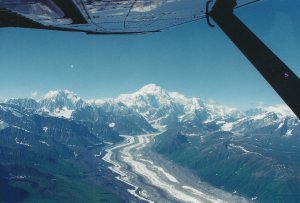
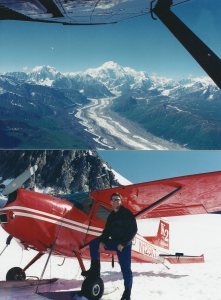
In Europa Journal, the lost World War II pilot, who vanished in the Bermuda Triangle, crash lands on a glacier high atop a mountain.
I thought you guys might like a glimpse of where I first got the idea.
This is a photo of me just after landing on a glacier on North America’s highest mountain, Mount McKinley, whose name was recently changed to its original Athabascan name of, Denali, “The Great One”.
Easily the most terrifying part is the landing. The runway is so short we had to dive below the glacier’s shelf and land on a 20 degree angle going upwards. This 20-degree up angle dramatically reduces your taxi time and keeps you from dropping off the other side. It’s pretty much a one-shot attempt. As we came in on our final approach the glacier literally filled up the entire cockpit windshield and it looked as though we were about to slam right into the mountain. Just when I thought this was it, I was about to become rock paste, the plane abruptly cleared the edge and began taxiing upwards. As the plane, and my stomach, bounced along the glacier on under-inflated Tundra tires, I hoped it would stop before we ran out of runway and dropped off the other side. When the engine finally died I remember thinking, I should probably start breathing again.
As I recall, it was a pretty nice summer day on top of the highest glacier in North America, and nowhere near as cold as you might think. Despite the warm temperatures, we still had a pretty awesome snowball fight. My best friend beamed me so hard he actually broke my sunglasses!
The take-off isn’t nearly as gut-wrenching as the landing but the view of the surrounding mountains and glacier fields on the way out is nothing short of spectacular.
Before we landed back in the small bush town of Talkeetna I already had at least five pages of notes.
Tagged: Alaska, Alaskan Wilderness, author, Denali, Glacier, ice, Jack Castle, landing, mountains, Mt. Mckinely, plane, snow, Terrifying Landing


Published on September 06, 2015 15:56
August 16, 2015
Star Wars, Anthony Daniels
Here’s me backstage with one of my favorite story tellers, Anthony Daniels, (better known as C-3P0)!!!
Tagged: Anthony Daniels, Chewbacca, Jack Castle, Luke Skywalker, Princess Leia, Star Wars


Published on August 16, 2015 11:28
August 14, 2015
Chewbacca/Peter Mayhew
Here is a picture of 7’3″ Peter Mayhew, (Chewbacca in all the Star Wars movies), towering over me on the back lot of MGM Studios.
Tagged: Backlot, Jack Castle, MGM Studios, Peter Mayhew, Star Wars


Published on August 14, 2015 13:41

